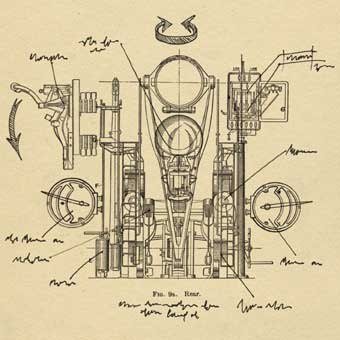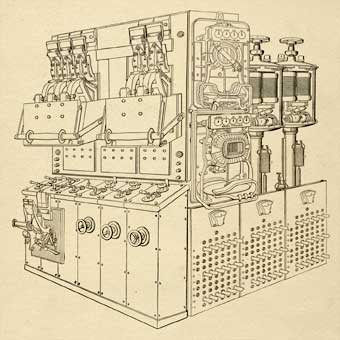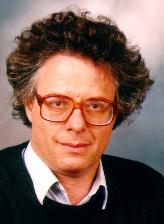
Why Was The Computer Invented When It Was?

In the closing days of the second world war, a truck left Göttingen carrying a mysterious machine marked with the code word V4. The V1, V2 and V3 were secret weapons with which Hitler had hoped to turn the tide of war, so it was not surprising that the truck was given high priority. After an adventurous journey, the machine ended up hidden in a cellar near the Austrian border.
We shall leave it there while we step back and reflect on the question raised by my title. Clearly the modern electronic computer had to wait until modern electronics - but could not some steam powered or clockwork version have been built earlier?

Bust of Leibniz by Johann Gottfried Schmidt
One of the many dreams of the Renaissance was the dream of the machine. Renaissance books show pictures of machines to lift water, to play music, to fly and to destroy enemies, Few, if any, of the devices had any chance of working but the desire to remove the barrier between the living and non-living had entered humanity's bloodstream.
It is no accident that some of the earliest mechanical calculators were designed by the philosophers Pascal and Leibniz. Pascal's machine could add and Leibniz's machine could multiply. Objects of metal had acquired skills which had seemed the province of the soul. In his philosophical work, Leibniz was prepared to consider the prospect of thinking machines.
...supposing there were a machine, so constructed as to think, feel and have perception, it might be conceived as increased in size, while keeping the same proportion, so that one might go into it as in a mill. That being so, we should, on examining its interior, find only parts which work upon one another, and never anything to explain a perception.
Leibniz was also concerned with a related idea, that of the algorithm. An algorithm is a set of instructions for carrying out a calculation without the calculators making any decisions for themselves. Such a calculation requires no "free will" and "reduces the calculator to a machine". Leibniz considered the possibility of algorithms which would apply to logical argument as well as mathematics.

Priceless, or nearly so. Image © Smithsonian Institute 1993.
Although Pascal tried to commercialise his machine, it was not until the middle of the 19th century that adding machines were made and sold successfully. Earlier machines were simply too delicate for constant use. It is instructive to compare the case of the adding machine with that marvel of 18th century technology, the precision clock. Three differences stand out.
- Even a moderate time-keeper is so useful that it commands a ready market. An adding machine is only attractive if it as accurate and cheap as a clerk.
- It was clear that a clock accurate enough to allow the solution to the problem of finding longitude at sea would be, if not priceless, nearly so. A perfect adding machine would just be a machine for adding.
- Part of the solution to making a good clock is to make the mechanism "do as little work as possible" and to protect it from the outside world. An adding machine must take its data from the outside world and return its results to the outside world. It cannot lead the pampered and lazy life of a clock.

Where an obvious need existed, technological difficulties could be overcome. In the early 1800's, the French weaver Joseph Jacquard invented a loom in which a series of punched cards controlled the patterns of cloth and carpet produced. Within a few years, tens of thousands of Jacquard and Jacquard inspired looms were in operation.
Before Jacquard, machines were built to do one thing. Clocks told the time, windmills ground corn, cranes lifted things and so on. Now there was a machine which could be instructed to do many things simply by changing a pattern of holes on a card.
In 1820, Babbage became interested in the construction of a special purpose machine to automate part of the process of table making. This project was sufficiently important to attract substantial government backing, but no machine was built. We know that the designs were feasible since a few machines based on Babbage's ideas were actually built and operated during the 19th century. A plausible argument can be made that the British Government's investment was more than repaid by the Babbage project's role as a nursery for British precision engineering.
One of the reasons for the failure to build a machine was its replacement in Babbage's mind by the grander project of a universal machine able to carry out any mathematical calculation. We know that Babbage's final plans were logically sound and that he did indeed design the mechanical equivalent of today's electronic computer. Could his universal "Analytical Engine" have been built and operated? Opinions differ. Many fortunes were lost before typesetting could be reliably mechanised. Even if a "demonstration model" of a Babbage machine could have been constructed (most people agree that it could) the nature of the technology meant that scaling up to bigger machines would have involved new difficulties.
In my view, one of the chief obstacles to the realisation of the Analytical Engine was the failure to imagine tasks grand enough for the grand machine. I am not aware of any proposal to use the machine for purposes where human labour could not do the job reasonably well.
One task where humans seemed inadequate was processing the results of the US census. It took seven years to tabulate the results of the 1880 census and something new was obviously needed for the 1890 census. The something new was provided by Hollerith who used a system based on punched cards. Once the data had been entered onto the cards, sorting and counting was done mechanically. This time, processing took only two years and produced a superior product. Over the next fifty years, the use of such "punched card" machines grew steadily as did their capabilities and the uses to which they were put.
The years from 1870 to 1960 also saw the invention and use of a number of "analogue computing machines". Roughly speaking, these machines modeled a physical system by mechanical or electrical means. One of earliest was the very successful Kelvin tide predictor in which a complex arrangement of wheels and pulleys drew a graph showing the sea level to be expected at a given port at a given time. One of the last and apparently most spectacular was an immense agglomeration of glass tubes, plumbing and coloured water which was intended to model the British economy.

Many of these analogue machines were both ingenious and useful but from our point of view they were merely special purpose devices. We are more interested in a byproduct of the foundational crisis which struck mathematics during the first part of the 20th century. This was the analysis of the notion of computation by Turing and others. Turing showed that it was possible to build "universal computing machines" which could do anything that any other "computing machine" could do. Instead of having to build a new device for each problem, we can build a single machine to do anything. Moreover, Turing's analysis showed that the "natural design", seen, for example, in Babbage's Analytical Engine, gave a universal machine.
As is well known, Turing spent the second world war breaking German military codes. Turing and his co-workers built a succession of machines to help them in this task. The first, the famous bombes, were special purpose devices. The last, Colossus, was still built for a single purpose but it was clear that those who designed and used it knew how to design and build an electronic universal computer.
What of the V4 in its Austrian cellar? It was not a weapon of war but another computing machine, the Z4, the fourth design of Konrad Zuse. Of it too, one could say that the man who built it knew how to design and build an electronic (strictly speaking, electro-mechanical) universal computer. The Z4 was installed at Zurich in 1950 with some modifications and matched the performance of computers elsewhere.
To this list could be added at least three groups in the United States, of which the group headed by Eckert and Mauchly was ultimately the most influential in shaping future developments. Within two or three years, several true electronic universal machines had been built. (Using one definition, the first one actually to operate was the Cambridge EDSAC, but the guiding ideas behind the Cambridge machine came from elsewhere.)
Why was the universal machine built when it was built? The first answer might be that it was called into being by military needs. This is not a satisfactory explanation. Some of the groups mentioned above were indeed aided by the state of war but others (particularly Zuse) were hindered. A more satisfactory explanation would start from two observations.
- The advance of engineering meant that many useful components were available "off the shelf".
- Changes in the way that mathematics was applied to physics and engineering meant that there were many important problems which required computations of a size beyond human capabilities. (Zuse's machine was intended to study flutter in aeroplane wings.)
Could a universal machine have been built earlier? What follows are personal and not very valuable opinions. We are used to very powerful machines but our answer must depend in part on the minimum computational power which might make a universal machine worth building. My view is that a machine that could reliably carry out a program involving a few thousand calculations (additions, multiplications and so on) and take only a few hours to do so would have found many uses from 1900 onwards. Even the earliest universal electronic computers could do a hundred times better than this, but we are asking for the minimum satisfactory performance.
I suspect that someone combining the insight of a Turing or a Babbage with a similar genius for tinkering could have produced such a computer on the basis of Hollerith punched card machines. Less controversially, telephone relays were available, reasonably cheap and reliable in the 1920s and these were to form the basis of Zuse's computers.
Looked at this way, the answer to the question posed in my title is that the computer was not "invented", but "emerged" when the technology was available to build it and sufficient problems existed to occupy it. It could have emerged earlier, but the further we go back in time, the more difficult it would have been to make it work reliably and to find appropriate problems which required its use.
Further Reading
- W. Aspray (Editor), Computing before Computers, Iowa State University Press, Ames, Iowa, 1990.
- N. Metropolis, J. Howlett, Gian-Carlo Rota, (Editors) A History of Computing in the Twentieth Century, Academic Press, New York, 1980.
About the author

Tom Körner is a lecturer in the Department of Pure Mathematics and Mathematical Statistics at the University of Cambridge, and Director of Mathematical Studies at Trinity Hall, Cambridge. His popular mathematics book, The Pleasures of Counting, was reviewed in Issue 13 of Plus.
He works in the field of classical analysis and has a particular interest in Fourier analysis. Much of his research deals with the construction of fairly intricate counter-examples to plausible conjectures.
Comments
Anonymous
very nice work. this will really help me with my school project.
Anonymous
This is a good source
Anonymous
Helped so much with my PLP/RTA
Anonymous
Thanks
paps
so why was the computer invented......?
Archie
this will help alot